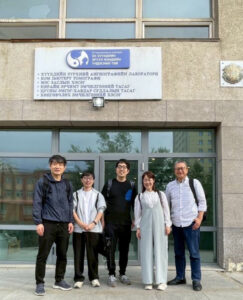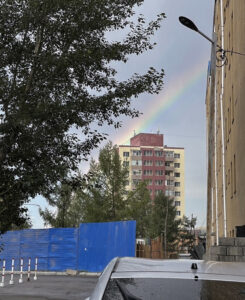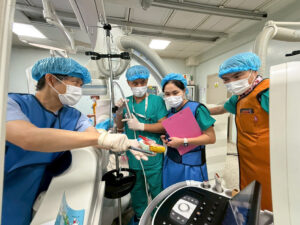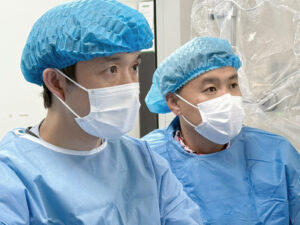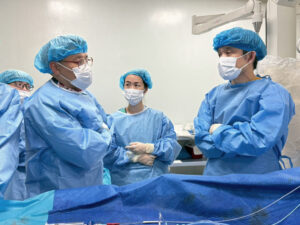August 2025 Catheterization Team Activity Report
10/1/2025
The second treatment support activity of FY2025 in Mongolia’s capital was carried out according to the following schedule. At the same time, a regional screening program was also conducted; however, this report mainly covers the catheterization treatment support activities in Ulaanbaatar.
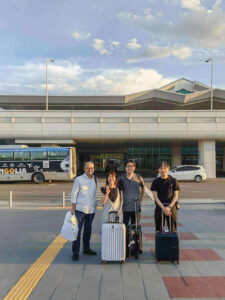
From left: Dr. Kataoka, Dr. Matsuo, Dr. Kashiwagi, Dr. Kise
Schedule
-
August 8 (Fri)
Departed Narita at 14:40 on MIAT Mongolian Airlines, arrived at Chinggis Khaan International Airport at 19:15 (about 1.5 hours to the city center). -
August 9 (Sat)
Morning: Echocardiographic screening of 112 patients at the National Center for Maternal and Child Health (NCMCH).
Afternoon: 5 therapeutic catheterization cases. -
August 10 (Sun)
Morning rounds; catheterization for 4 cases, TEE only in 1 case, 1 canceled.
After completion, held a general conference. -
August 11 (Mon)
Departed hotel early morning; 07:45 departure from Chinggis Khaan Airport, arriving at Narita at 13:40 on MIAT Mongolian Airlines. Disbanded at the airport.
Members
-
Leader: Dr. Koichi Kataoka (Hiroshima Citizens Hospital)
-
Members: Dr. Hiroaki Kise (Showa University Hospital), Dr. Kumiyo Matsuo (Osaka Women’s and Children’s Medical Center), Dr. Kosuke Kashiwagi (Ehime University Graduate School), Dr. Mizuki Akiyoshi (Shimane University Hospital)
-
Secretariat: B. Tuya
-

In front of The NCMCH
Achievements
On August 9 (Sat), the team departed the hotel at 8:00, and echocardiography was conducted for 112 waiting patients at NCMCH starting at 9:00. Originally planned to finish in the morning, the high number of patients gathered by the hospital required screenings to continue into the afternoon, running in parallel with catheterization. Children who underwent echocardiography received heart-shaped origami gifts kindly provided by Edwards Lifesciences before our departure. In addition, get-well cards from Edwards Lifesciences were given to patients who received treatment.
Catheterization on the first day involved 5 cases (PDA, PDA, PS, PDA, PDA). All procedures were conducted jointly with Mongolian physicians. The third case finished around 19:00, with a rainbow visible outside in the evening sky. The fifth case was led primarily by Dr. Bat-Undrakh of Mongolia. Although NCMCH’s anesthesiology department was initially scheduled for two-person coverage, it was reduced to one. Procedures finished late at night, leaving no time for a conference that day.
On August 10 (Sun), the team departed the hotel at 8:00, with a full day of catheterization: 4 ASD cases, 1 TEE-only case, and 1 PDA case canceled due to a cold. A conference was held afterward in English. The first and second cases were led by Japanese physicians, while the third and fourth were led by Dr. Bat-Undrakh. This physician, designated as the primary trainee of the Heart Saving Project, had previously been abroad for training in May and could not join us then. In August, however, he showed greater confidence, likely due to his overseas experience, and actively communicated with us in English.
On both days, there were repeated equipment troubles: the angiography machine frequently malfunctioned, causing great stress for everyone involved. Although such machines require regular maintenance, it appears NCMCH has not conducted any. Local staff speculated the malfunctions were due to long continuous use, attempting to resolve it by powering off and rebooting, though this was not an effective solution.
On the other hand, transesophageal echocardiography (TEE) was performed by the Japanese team during the initial evaluation and treatment, while Dr. Khongor performed the rest. Dr. Bat-Undrakh participated in all catheterization sessions both days and led several cases. During conferences, Mongolian physicians actively asked questions in English, showing strong initiative. The overall atmosphere of joint activities has improved significantly.
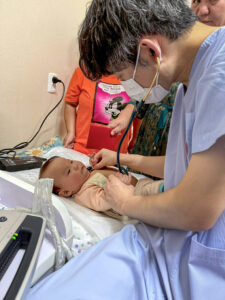
Dr. Kise performing a heart ultrasound for children.
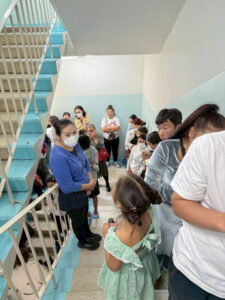
A long line of patients waiting for heart ultrasound screenings.
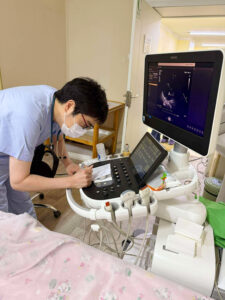
Dr. Kashiwagi performing a heart ultrasound
Summary of procedures:
-
Echocardiographic screenings: 112 patients
-
Therapeutic catheterizations: 9 cases (PDA 4, PS 1, ASD 4)
-
TEE only: 1 case
-
Canceled: 1 case
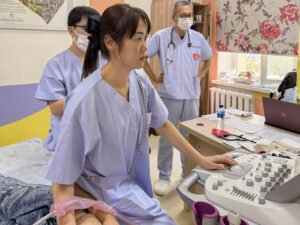
Dr. Matsuo performing a heart ultrasound for children.
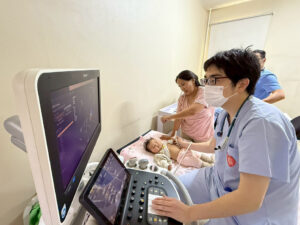
Dr. Kashiwagi performing a heart ultrasound for children.
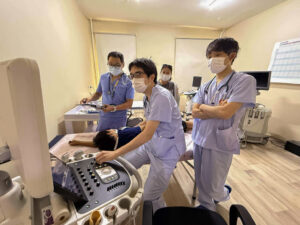
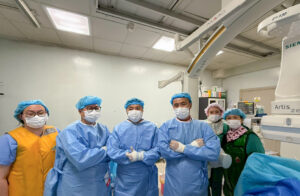
the Japan-Mongolia joint medical team
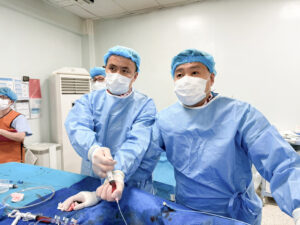
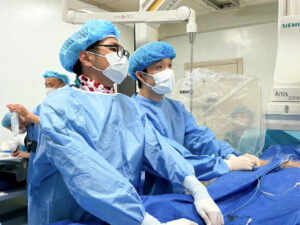
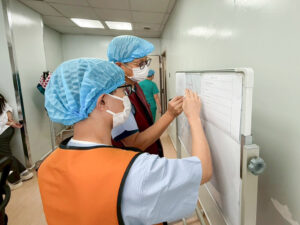
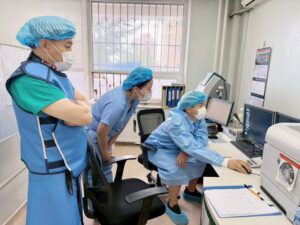
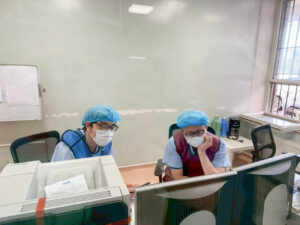 Due to ticket arrangements, Dr. Akiyoshi arrived in Mongolia on August 7. On the evening of August 8, the rest of the team arrived in Ulaanbaatar, had dinner, and concluded the day. Accommodation was at the Bayangol Hotel.
Due to ticket arrangements, Dr. Akiyoshi arrived in Mongolia on August 7. On the evening of August 8, the rest of the team arrived in Ulaanbaatar, had dinner, and concluded the day. Accommodation was at the Bayangol Hotel.
As in May, there was concern that necessary devices might not be available at the hospital, which could hinder scheduled treatments. Fortunately, the devices ordered in April were delivered just before our arrival.
Overall Reflections
-
Patient selection for echocardiography:
The large number of 112 patients extended screenings into the afternoon. For better follow-up, it would be preferable to pre-select patients to avoid overconcentration in one session. -
Team role distribution:
Within the team, assigning clear roles (catheter operations, TEE, etc.) would allow members to focus and gain experience more efficiently. -
Device availability issues:
Although devices are said to be supplied quarterly, shortages of frequently used devices remain a problem. While this time delivery coincided with our visit, device supply must be stabilized as it directly affects treatment. -
Angiography machine malfunctions:
During this mission, the machine stopped three times, requiring 10 minutes each for rebooting. One incident occurred immediately after device placement, causing great stress. Regular maintenance is essential. NCMCH has stated they plan to contract a maintenance company before our next visit in November, but if this is not ensured, cancellation of the next mission may be unavoidable. They also indicated that replacement parts may not be budgeted for this fiscal year, which must be addressed urgently. -
Progress of NCMCH physicians:
Dr. Bat-Undrakh acted as lead operator in 2 cases and participated in nearly all others. Other physicians also showed strong motivation, and the overall atmosphere has greatly improved. Continued role-specific training and focus on individual skills will further accelerate their growth. -

A rainbow appeared outside the hospital window.

Dr. Kise explaining the device.


Closing
We sincerely thank all participants and supporters who made possible this second catheterization support activity in Mongolia in 2025. Your contributions are deeply appreciated.
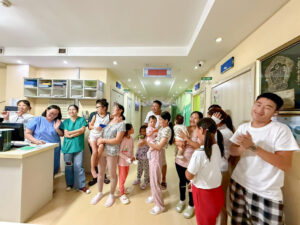
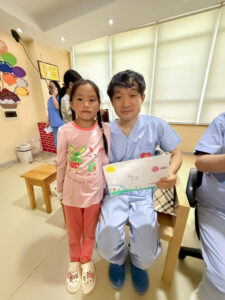
A patient giving the doctor a picture they drew.
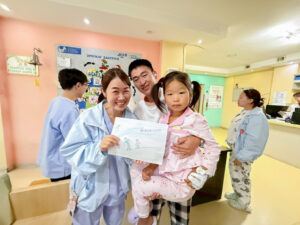
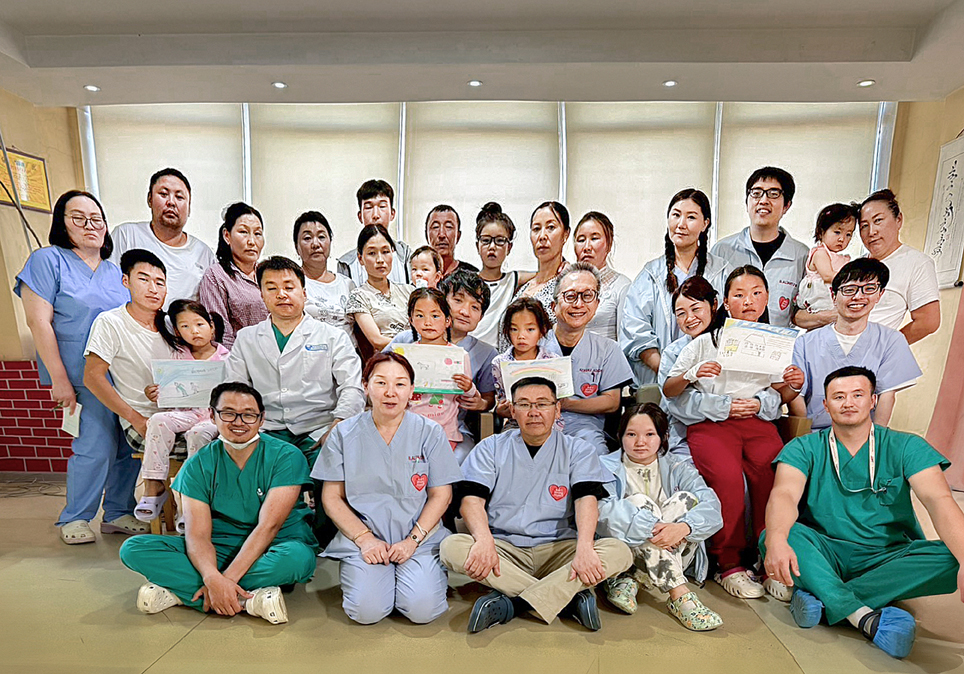
The patient who received treatment this time, his/her parents, and all the staff in Japan and Mongolia

